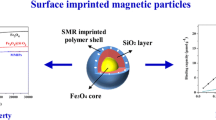Abstract
Magnetic hydrophilic molecularly imprinted polymer (MIP) particles were successfully synthesized via an inverse suspension polymerization in silicone oil, by employing methacryloxypropyltrimethoxysilane(MPS)-modified Fe3O4 nanoparticles as magnetic particles, 2,4-dichlorophenoxyacetic acid (2,4-D) as template, hydroxyethyl methacrylate (HEMA) as hydrophilic monomer, and acetonitrile as high polar porogen. The synthesized magnetic hydrophilic MIP particles could be separated rapidly under an external magnetic field. About 94% transmittance of the particlewater suspension could be reached within 20 min by magnetic separation, whereas about 84% transmittance was achieved after at least 180 min by sedimentation. The adsorption capacity of the particles was also studied in pure aqueous environments. These hydrophilic MIP particles had a higher selectivity for templates. Hydrophilic MIP particles took on a higher imprinting factor than hydrophobic MIP particles and 2,4-D were able to rebind hydrophilic MIP particles more easily than 4-Chorophenoxyacetic acid.
Similar content being viewed by others
References
G. Wulff, Chem. Rev., 102, 1 (2002).
K. Haupt and K. Mosbach, Chem. Rev., 100, 2495 (2002).
G. Wulff, Microchim Acta, 180, 1359 (2013).
A. Martín-Esteban, Trends in Analytical Chemistry, 45, 169 (2013).
Y. Yin, Z. Dong, Q. Luo and J. Liu, Progress in Polymer Sci., 37, 1476 (2012).
K. Yang, J. Liu, S. Li, Q. Li, Q. Wu, Y. Zhou, Q. Zhao, N. Deng, Z. Liang, L. Zhang and Y. Zhang, Chem. Commun., 50, 9521 (2014).
J. Wang, J. Li, H. Li and L. Ding, Mater. Lett., 131, 9 (2014).
E. Asadi, S. Azodi-Deilami, M. Abdouss, D. Kordestani, A. Rahimi and S. Asadi, Korean J. Chem. Eng., 31, 1028 (2014).
L. Piscopo, C. Prandi, M. Coppa, K. Sparnacci, M. Laus, A. Laganà, R. Curini and G. D’Ascenzo, Macromol. Chem. Phys., 203, 1532 (2002).
M. Zhao, X. Chen, H. Zhang, H. Yan and H. Zhang, Biomacromolecules, 15, 1663 (2014).
T. Zhou, L. Jørgensen, M. Mattebjerg, I. Chronakis and L. Ye, RSC Adv., 4, 30292 (2014).
X. Shen, C. Xu and L. Ye, Soft Matter, 8, 7169 (2012).
V. Bulmus, Y. Chan, Q. Nguyen and H. Tran, Macromol. Biosci., 7, 446 (2007).
F. Xu, E. Kang and K. Neoh, Biomaterials, 27, 2787 (2006).
B. Gao, Y. Yang, J. Wang and Y. Zhang, J. Biochem. Molecular Toxicology, 22, 166 (2008).
C. Gomez, G. Pastrana, D. Serrano, E. Zuzek, M. Villar and M. Strumia, Polymer, 53, 2949 (2012).
B. Dirion, Z. Cobb, E. Schillinger, L. Andersson and B. Sellergren, J. Am. Chem. Soc., 125, 15101 (2003).
H. Daniel, B. Michal, M. Hana and J. B. Milan, J. Sep. Sci., 30, 1751 (2007).
C. Gonzato, M. Courty, P. Pasetto and K. Haupt, Adv. Funct. Mater., 21, 3947 (2011).
M. Ding, X. Wu, L. Yuan, S. Wang, Y. Li, R. Wang, T. Wen, S. Du and X. Zhou, J. Hazard. Mater., 191, 177 (2011).
X. Wang, L. Wang, X. He, Y. Zhang and L. Chen, Talanta, 78, 327 (2009).
Y. Zou, C. Zhao, J. Dai, Z. Zhou, J. Pan, P. Yu, Y. Yan and C. Li, Colloid Polym. Sci., 292, 333 (2014).
W. Zheng, F. Gao and H. Gu, J. Magn. Magn. Mater., 288, 403 (2005)
Y. Sun, X. Ding, Z. Zheng, X. Cheng, X. Hu and Y. Peng, Chem. Commun., 26, 2765 (2006).
X. Wang, X. Ding, Z. Zheng, X. Hu, X. Cheng and Y. Peng, Macromol. Rapid Commun., 27, 1180 (2006).
Author information
Authors and Affiliations
Corresponding author
Rights and permissions
About this article
Cite this article
Wang, X., Qiu, G., Ge, Y. et al. Highly selective magnetic polymer particles via molecular imprinting. Korean J. Chem. Eng. 32, 2355–2360 (2015). https://doi.org/10.1007/s11814-015-0055-5
Received:
Accepted:
Published:
Issue Date:
DOI: https://doi.org/10.1007/s11814-015-0055-5




